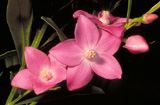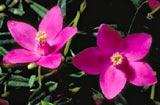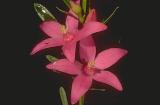|
[Front Page] [Features] [Departments] [Society Home] [Subscribe]

The Adaptable and Rewarding Crowea
Norm McCarthy
The genus Crowea - family Rutaceae, is named after James Crowe, an English botanist. The plants are very similar to those of Eriostemon, Philotheca and Boronia, also in the same plant family. There are three species in this hardy, ornamental and very desirable, endemic genus.
Croweas are easily grown, long lived and eminently suitable for all gardens, large or small. Normal growth does not exceed one metre in height or width quite often less. However, dwarf forms exist and will receive further mention.
There are few pests or diseases so they are usually trouble-free plants. There is a remote chance of an infestation of white scale and black smut could occur. This is easily controlled by spraying a solution of 1% white oil on the foliage. Use only at night or morning to avoid the heat of the day. One, or possibly two, applications should be sufficient. However, as the plants are so robust, there is little chance of infestation. Croweas are really quite tough, enduring and completely frost tolerant.
 |
Crowea saligna and its cultivars are rewarding plants for a sheltered position in the garden.
Select the thumbnail image or highlighted name for a higher resolution image (23k).
|
All species prefer to grow in a moist, well-drained position, with some protection from winds. A part-sun, part-shade, situation amongst other shrubs is ideal. However, plants of C.exalata have been growing in full sun without apparent problems. With full sun of course, plants need to be well watered Some form of mulching to retain moisture is a great help. Amazingly enough Crowea species adapt to a wide range of soils. They will accept liquid fertilizer used sparingly, at monthly intervals.
Croweas, if desired, can be grown as pot plants, using large pots. They can then be placed on verandahs and patios where they do quite well. As cut flowers, they are highly recommended and last well indoors.
Flowers - usually in varying shades of pink, which range from very pale to dark and almost red. White forms also occur. Flowers are five petalled, waxy and star shaped. On all plants, flowers appear in the leaf axils (axillary). Propagation - seed is not easy to obtain and the usual method of reproduction is by cuttings. This vegetative method is easy and quick and also ensures plants coming true to type. The optimum time to take cuttings is early mid to late summer but spring and autumn cuttings should also yield good results. Cuttings taken thus should produce roots in six to eight weeks. Pruning - to improve the growth habit of croweas, plants should be tip pruned as they develop. This practice keeps them dense and compact and increases their flowering potential. Also, keeping the plant in good shape reduces any tendency for it to become leggy.
Crowea Species
Crowea angustifolia
angustifolia = narrow leaves
This species is endemic to Western Australia and is rarely available in the eastern States. It occurs as a small to medium shrub with narrow leaves and pale pink or white flowers. There are two varieties: var. angustifolia and var. dentata. There is a dwarf form of var. angustifolia only 0.25 metres tall...on the other hand, var. dentata can be three metres tall with white flowers.
Crowea saligna
saligna = willow like
This species grows from 0.5 to one metre tall with a similar spread and is inclined to be an open spreading shrub. Pruning could aid in keeping a denser habit. Leaves are bright green, alternate and not over-numerous. Leaf size is 5 cm by 2 cm. The flowers are quite large, up to 4 cm across, light to dark pink, sometimes white and again, not over-numerous. What they lose by number is made up for by the peerless beauty of individual blossoms. The main flowering period is usually midwinter, but sporadic bursts of blooms can occur at other times, i.e. after good rains. To my knowledge, the species occurs mainly on the Hawkesbury Sandstone around Sydney, in an area renowned for its flora.
Crowea exalata
exalata = without wings
This species is surely the best known and most widely grown of all. It occurs mainly in north and eastern Victoria, the south coast of New South Wales and, like C.saligna, it proliferates around Sydney in Hawkesbury sandstone areas. It usually attains a height of 0.75 metres by 0.75 metres although it is sometimes found in more dwarf forms of approximately 0.25 metres. The foliage is crowded with leaves bright green and alternate. The leaf size is small, about 3 cm by 1.5 cm. Flowers are normally pink and profuse, occasionally white. Flowering is mainly in late summer/autumn but the plant almost always produces a few flowers. Good conditions and consistent moisture prolong the flowering period and the quantity of bloom. The foliage is aromatic when crushed and is reminiscent of aniseed.
 |
Two colour forms of Crowea exalata; the normal pink form, (top) and an unusual white form (bottom) .
Select the thumbnail image or highlighted name for a higher resolution image (28k and 23k).
|  |
Hybrids and Other Forms
Some excellent hybrid and other forms are available at specialist nurseries from time to time. Perhaps some are worthy of mention in detail.
Crowea 'Poorlnda Ecstasy'. This is one of the most reliable cultivars and is stated to be a saligna x exalata hybrid. In overall appearance and habit, however, it appears to be a good form of Crowea saligna with pale pink flowers. Flowers are not over abundant.
Crowea exalata 'Bindalong Compact'. This is a low growing compact form with pink flowers. It is a good dwarf from the Victorian Alps and grows 0.5 metres tall and 0.75 metres wide.
Crowea exalata 'Austraflora Green Cape'. This is yet another dwarf form of Crowea exalata, low and spreading. It originates from the Green Cape area on the south coast of New South Wales. This one is only 0.15 metres tall by 0.6 metres across. The flowers are mauve, but as aging occurs, they may change to white, then to green.

|

|
Crowea 'Festival'. This is an outstanding, select form which arose from seed in a suburban garden on Sydney's north shore. The flowers, foliage and period of flowering make C. 'Festival' an very superior form. Its almost continuous flowering enhances the delightful characteristics of this exciting cultivar.
|
|
Select the thumbnail image or highlighted name for a higher resolution image (16k).
|
From "Australian Plants", the journal of the Association of Societies for Growing Australian Plants, September 1988 issue.

[Front Page] [Features] [Departments] [Society Home] [Subscribe]
Australian Plants online - June 2000
Association of Societies for Growing Australian Plants
|